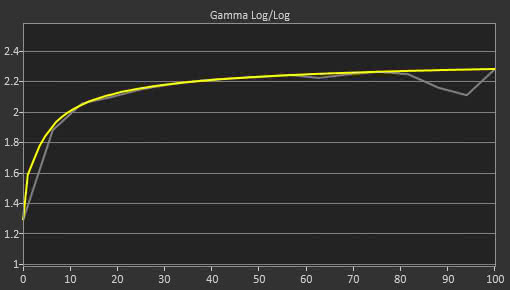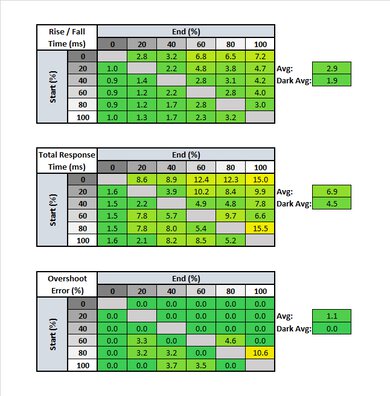Our Verdict
The ViewSonic XG2402 is a decent monitor for most uses. It is especially well suited as a gaming monitor, thanks to the fast response time, high refresh rate, and FreeSync support. It has a good stand and good ergonomics, so it can easily be adjusted to a more comfortable viewing position. Unfortunately, it has poor dark room performance and disappointing viewing angles.
- Great gaming performance, with FreeSync support and a 144 Hz refresh rate
- Excellent fast response time with low motion blur
- Poor dark room performance
- Disappointing viewing angles
Decent monitor for office use. It has a good stand that is easy to adjust to an ideal viewing position. It has good peak brightness, and good reflection handling, so there should be no issues in a bright office setting. Unfortunately, it has disappointing viewing angles, and the 24", FHD screen isn't great for multitasking.
The ViewSonic XG2402 is a great gaming monitor. It has an outstanding response time, and a fast refresh rate with FreeSync VRR support, great for PC or Xbox One S/X gaming. It has excellent low latency, ensuring a responsive gaming experience. Unfortunately, it doesn't look as good in a dark room, so it may be disappointing for late night gaming sessions.
Decent monitor for multimedia. The 24", 1080p screen isn't as sharp as today's typically larger, 4k screens. It also doesn't perform well in a dark room, and has disappointing viewing angles. It has an excellent fast response time, so fast moving objects look clear with little motion blur.
The XG2402 is a decent monitor for media creation. It is limited by the 24", FHD screen, so it isn't as easy to multitask or see your entire project. It also doesn't support the Adobe RGB color space, which may be disappointing to those working in the print industry.
The XG2402 does not support HDR. For a good HDR monitor, check out the Samsung CHG70.
Changelog
- Updated May 29, 2020: Converted to Test Bench 1.1.
- Updated Jan 17, 2019: We tested the monitor's compatibility with NVIDIA's new FreeSync driver. See our full investigation into NVIDIA's FreeSync Drivers here.
- Updated Oct 16, 2018: Review published.
- Updated Oct 14, 2018: Early access published.
Check Price
Differences Between Sizes And Variants
We tested the 24" ViewSonic XG2402. It is also available in 27" (XG2702), and for the most part, we expect our review to be valid.
If someone comes across a different type of panel or if their ViewSonic XG2402 doesn't correspond to our review, let us know and we will update the review. Note that some tests such as the gray uniformity may vary between individual units.
| Model | Size | Resolution | Refresh Rate | Notes |
| XG2402 | 24" | 1080p | 144 Hz | FreeSync |
| XG2702 | 27" | 1080p | 144 Hz | FreeSync |
The XG2402 we reviewed was manufactured in June 2018
Popular Monitor Comparisons

The ViewSonic XG2402 is a decent monitor for most uses. It is a great gaming monitor (see our recommendations for the best gaming monitors and the best gaming monitors under $300), and it is aggressively priced to beat the competition. See also our recommendations for the best 24-25 inch monitors and the best budget monitors.
The ViewSonic XG2402 is better than the ASUS VG248QE. Overall, the two are very similar, with very similar performance under most uses. The XG2402 supports AMD FreeSync, making it a better choice for gaming. The XG2402 also has better color volume.
The AOC AGON AG271QX is slightly better than the ViewSonic XG2402. The AG271QX is better at displaying large areas of similar color, as it supports 10-bit color. However, the main advantage of the AGON AG271QX is the larger, higher resolution screen, that makes it much easier to see fine details in games and for multitasking.
The ViewSonic XG2402 is much better than the ASUS VG245H. The XG2402 has a higher refresh rate, and a wider FreeSync range, ensuring a more fluid, tear-free gaming experience. The ViewSonic also has a better response time, so fast-moving objects appear clear with no blur trail. The ViewSonic also has much better color volume, although it has worse native contrast.
The Dell S2417DG is slightly better than the ViewSonic XG2402. The Dell S2417DG is a G-SYNC monitor, with a higher 2560x1440p resolution, so you can see more fine details in games or multitask easier. The ViewSonic XG2402 is a FreeSync monitor, great for Xbox One S/X gamers, or if you have an AMD graphics card. The Dell also has an option to introduce flicker to help reduce motion blur.

We buy and test more than 30 monitors each year, with units that we buy completely on our own, without any cherry-picked units or samples. We put a lot into each unbiased, straight-to-the-point review, and there's a whole process from purchasing to publishing, involving multiple teams and people. We do more than just use the monitor for a week; we use specialized and custom tools to measure various aspects with objective data-based results. We also consider multiple factors before making any recommendations, including the monitor's cost, its performance against the competition, and whether or not it's easy to find.
Test Results

Very good ergonomics. The XG2402 is very easy to adjust to an optimal viewing position. Note that the ViewSonic website lists the tilt range as -20° to +5°, but we measured -15° to +5°.
The back of the XG2402 looks decent. It has a slightly stylized design and the red chevrons on the back light up. There is single heat vent out the top of the monitor. Unfortunately, there isn't much in terms of cable management.
Disappointing contrast ratio. Blacks look gray in a dark room. These results are typical for TN monitors, and worse than most IPS monitors. If you want a monitor with a better contrast ratio, check out the AOC 24G2.
The ViewSonic XG2402 does not have a local dimming feature. The above video is provided for reference only.
Very good peak brightness. There is only slight variation in brightness with content, which is good.
HDR is not supported.
The ViewSonic XG2402 has poor horizontal viewing angles. Uniformity issues are noticeable if sitting too close to the monitor, and it is not ideal for sharing your screen with someone else. If you want a monitor with better viewing angles, check out the Acer Nitro RG241Y.
Mediocre vertical viewing angles. Due to the structure of TN panels, the image remains accurate at wider angles from above than from below. This is typical of monitors with TN-type panels and much worse than monitors with IPS type panels like the Asus VG279Q.
Out of the box, the XG2402 has great accuracy. The most accurate Picture Mode is 'Custom 1', but 'MOBA' is also good. White balance and color errors are low, and most enthusiasts won't notice the inaccuracies. Gamma follows the target curve, but is a bit bright, even with Gamma set to 2.4.
After calibration, the XG2402 has nearly perfect color accuracy. The remaining inaccuracies are too small for anyone to notice. Gamma follows the target curve almost perfectly.
You can download our ICC profile calibration here. This is provided for reference only and should not be used, as the calibration values vary per individual unit even for the same model due to manufacturing tolerances.
s.RGB Picture Mode: Custom 1 (calibrated)
Adobe RGB Picture Mode: Custom 1
Excellent SDR color gamut, with nearly 100% coverage of the s.RGB color space. Adobe RGB coverage is decent, but insufficient for most professional users working in print.
s.RGB Picture Mode: Custom 1
Adobe RGB Picture Mode: Custom 1
Excellent color volume. Unfortunately, it can't produce deep, dark colors due to the limited contrast ratio, but it fills out the color gamut well.
HDR is not supported.
HDR is not supported.
| Rampage Response Setting | Response Time Chart | Response Time Tables | Motion Blur Photo |
| Standard | Chart | Table | Photo |
| Fast | Chart | Table | Photo |
| Faster | Chart | Table | Photo |
| Ultra Fast | Chart | Table | Photo |
| Fastest | Chart | Table | Photo |
The XG2402 has an outstanding fast response time. Most transitions are nearly instantaneous, and there is almost no measurable overshoot. This produces clear motion, with next to no noticeable motion blur. The lack of motion blur may bother some people if the frame rate drops too low. We recommend the 'Fast' Rampage Response setting, as it delivers the best balance of response time and overshoot. There's some overshoot in that mode, but it's not really noticeable. Higher settings have slightly faster rise/fall times, but the total response time increases with each setting, as there's significantly more overshoot in each successive mode.
| Rampage Response Setting | Response Time Chart | Response Time Tables | Motion Blur Photo |
| Standard | Chart | Table | Photo |
| Fast | Chart | Table | Photo |
| Faster | Chart | Table | Photo |
| Ultra Fast | Chart | Table | Photo |
| Fastest | Chart | Table | Photo |
The ViewSonic XG2402 has an excellent response time at 60Hz. We still recommend the 'Fast' mode, but some people might prefer 'Faster' or even 'Fastest'. The higher modes have slower total response times on average, but some scenes are significantly faster. In our moving motion blur photo, 'Fastest' has the least amount of blur, but it's not necessarily representative of everyone's usage.
The XG2402 has an excellent 144 Hz refresh rate (it is one of the best 144Hz monitors we've tested so far), great for gaming. It supports FreeSync over HDMI and DisplayPort, and both have the same wide FreeSync range. In graphically demanding scenes where the framerate drops too low, the monitor uses LFC to compensate, ensuring a consistent tear-free gaming experience. If you want a monitor with a higher refresh rate, check out the Acer Nitro XF243Y.
Update 01/15/2019: We have tested the XG2402 with NVIDIA's new FreeSync drivers, and it works perfectly. When we tested it, FreeSync was automatically enabled on the monitor, and we had only to enable G-Sync in the NVIDIA Control Panel.
The ViewSonic XG2402 has outstanding low input lag, one of the best we've tested, slightly better than the MSI Optix G27C. The 60 Hz input lag is higher, but still excellent.
Only 1920x1080 is supported at 144 Hz.
The 24" screen is decent, but some users might find the 1080p resolution too low.
The 3.5mm analog audio out port is a headphone port with adjustable volume on the monitor's on screen display. It supports DisplayPort 1.2, but this must be enabled on the OSD.
The XG2402 has a few gaming-oriented features, including:
- RampageX: This setting controls the red accent lighting on the back of monitor.
- Black Stabilization: A customizable setting designed to make it easier to spot objects in dark scenes. Most monitors that have this feature have 4 setting levels, the XG2402 has 22.
- Custom 1,2,3: There are three customizable settings presets that allow you to completely customize the settings and save them. They can be renamed, which is rare.
- Monitor Hertz Cap: You can limit the monitor to 60 Hz, 100 Hz, or native (144 Hz). Note that with this enabled it is still possible to send a higher refresh rate, but this results in dropped frames.
The OSD always shows two pieces of information about the current state of the monitor. The bar on the left is the current power consumption of the monitor, expressed as a percentage of the maximum. The number on the right shows the current max refresh rate of the monitor, not the actual current refresh rate.













































